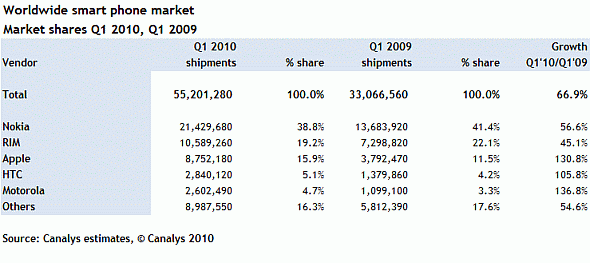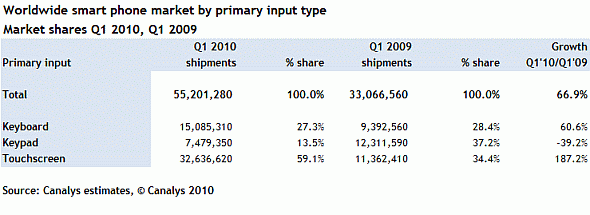From the Canalys press release:

All of which can be summarised by saying that Nokia's emphasis on the mid-tier is keeping the numbers growing nicely, in line with a generally rising market, with Apple making the most relative gains. Though Nokia's market share is still almost more than RIM's, Apple's and HTC's put together. With Symbian^3 handsets coming along to boost the top-end later this year, I still reckon the predicted death of Nokia and Symbian is severely misplaced.
Canalys also produce this interesting little table:

Look at that figure for keypad-driven smartphones (think N95, N96, N86 in the Symbian world) - in both absolute and relative terms this sector of the market has tanked. Qwerty-driven phones (think E71, E72, E55 in the Symbian world) have maintained their fraction of the overall market and have been selling amazingly successfully. While touchscreen phones (I'm assuming this includes hybrid designs, think N97 as well as 5800), somewhat predictably, now account for more than 50% of the entire smartphone market.
You'll remember Nokia's Capital Markets Day in 2009, where Nokia announced its 'three form factor' approach to the next few years: qwerty-only (so the E5 and successors); touchscreen (so 5230, X6, N8 and successors); and 'hybrid' (N97, C6 and successors). From these Canalys figures it seems that this plan should fit in well with the way the wider smartphone industry is going.
Also of interest in the Canalys press release was the info that, despite not appearing in the summary table above, Sony Ericsson saw "triple-digit growth", mainly for sales of its "Symbian platform products, the Vivaz and the Satio, which performed well in APAC and EMEA". Admittedly Q1 2009 would have been a quiet time for Sony Ericsson smartphones, but it's still good to know the Satio and Vivaz haven't been too badly received.
Steve Litchfield, AAS
